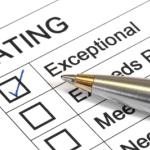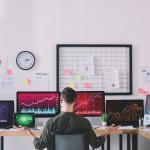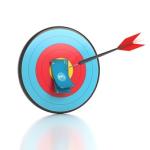I like to think of the various EPM/CPM methods as an analogy of musical instruments in...
Corporate Performance Management (CPM) concerns how an organisation manages its overall performance. As defined by Gartner, it involves combining the methodologies used to manage strategy, the metrics that evaluate performance, and the processes used to direct people within the organisation – all of which should be supported by a technology solution.
To support organisational decision-making, the framework combines the following four areas:
- A business model that describes how the business creates value.
- Strategic initiatives that are focused on improving parts of the business model.
- Organisational resources (money, people, assets) that can be applied to enable the business model to function and that allows strategic initiatives to be implemented.
- Management processes that direct and control planning, funding, and monitoring of business operations. All four components are intertwined and should operate within a CPM technology solution as a continuous approach to performance management. Around this core system will be a range of other Business Analytic solutions, such as Business intelligence (BI) and reporting/analysis applications, that directly support specific areas within the CPM model. Let’s take a closer look at each of these areas.
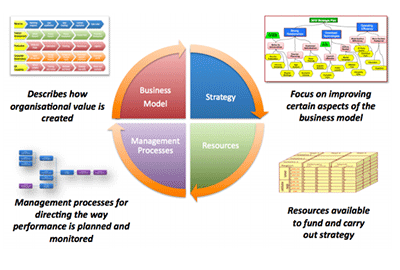
CPM Business Model
At the heart of a CPM system is an organisation model containing the relationship of activities that lead to organisational objectives. 
Although this model will differ between industries, it will typically include the following:
- how revenue/income is generated;
- how products/services are manufactured/created and distributed to customers;
- how employees are recruited, trained, and assessed; and
- how the organisation complies with its legal responsibilities.
These activities are linked to one or more organisation departments that determine those responsible for their execution.
Some activities will have a one-to-one relationship with the organisation structure, but other activities will go across multiple departments.
Quite often, the relationships between activities can be built as a Driver-Based model where the value of an input, such as the number of inquiries, can be used to determine the volume of sales and revenue via a set conversion rate. These models can be used to plan or assess the operation of the business by entering a few key values or ‘drivers’.
Business Model Metrics
Each activity can have different sets of measures that include:
- KPIs that measure the success of the activity (e.g. the number of new customers acquired);
- KPIs that reveal the state of implementation (e.g. the number of mailings made to the target customer base);
- The resources consumed by the activity (e.g. people time, costs, assets utilised);
- The risks involved in employing those activities.
Strategy 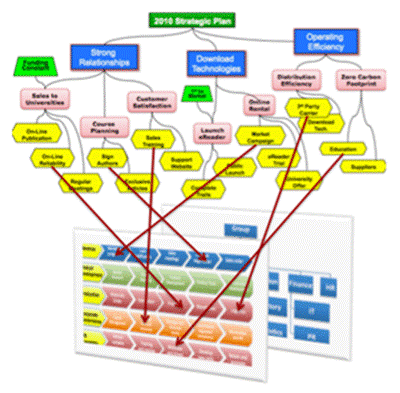
The second area – Strategy – typically has an emphasis on how the performance of the business model can be improved. It focuses on one or more organisational objectives and details specific strategic initiatives that describe how that improvement will be implemented and who will be responsible for their delivery.
The terminology involved depends on the management methodology being employed (e.g. Balanced Scorecard), but most methodologies will show the relationship between the action and the objective being supported as a ‘Strategy Map’.
Strategy Model Metrics
The sets of measures associated with strategy include:
- A set of targets that determine the improvement to be achieved for each supported objective;
- The resources that will be required to implement each associated initiative;
- The status through which the implementation of initiatives can be monitored;
- Any business assumptions made when agreeing on the initiatives and the value of an improvement.
Resources
The third element of the framework relates to the resources (money, people, assets) that the organisation has at its disposal, with financial resources often being the focus of a budget.
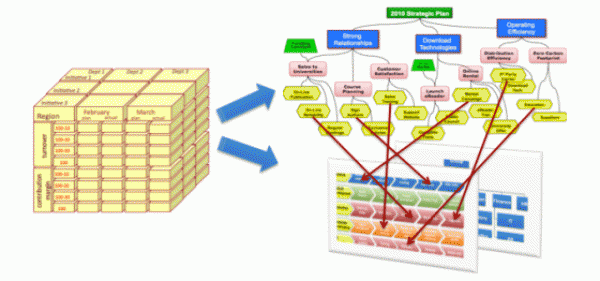
These resources should be allocated to sustain the business model and ensure that the agreed strategic initiatives are properly resourced at the right time.
Management Processes 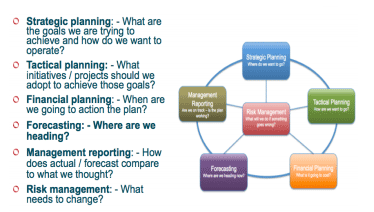
The final area of the framework is the organisation’s management processes that direct and control how performance is planned, resourced, implemented, and monitored.
These are typically seen and often implemented as the six distinct processes of Strategic Planning, Tactical Planning, Financial Planning, Forecasting, Management Reporting, and Risk Management.
However, on closer examination, these processes consist of a number of interconnected activities that only together form the basis for managing performance.
Consider the following schematic:

Even within each activity, there are interconnected tasks that each department has to perform in a specific order and at specific times.
For example, budgeting may start off with setting a high-level goal, which sales will decide on how this will be delivered throughout the year. To do this, they may need to collaborate with marketing and production.
Once this has been completed, other areas of the organisation can start allocating resources that fit in with the sales and marketing plan.
There are three essential things to bear in mind when designing processes:
- Although these are often seen as discreet processes, in reality, they are each comprised of multiple activities that have strong links with activities within other processes.
- For effective performance management, none of these processes can be left out.
- In today’s volatile business environment, these activities need to act as a single continuous process. Consequently, what goes on within these processes and how they are interconnected will determine whether performance gets managed.
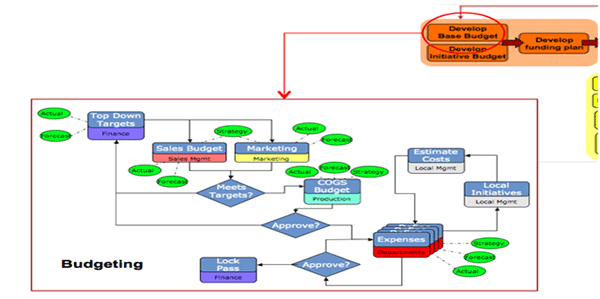
The Role of a Technology Solution
As with a car, these four components need to be combined and operated as a single technology solution. It needs to support decision-making through the total integration of driver-based business modelling (the engine) and strategy improvement plans (visual indicators showing the intended direction) with organisational resources (the fuel), all controlled through management processes (the pedals and steering wheel).
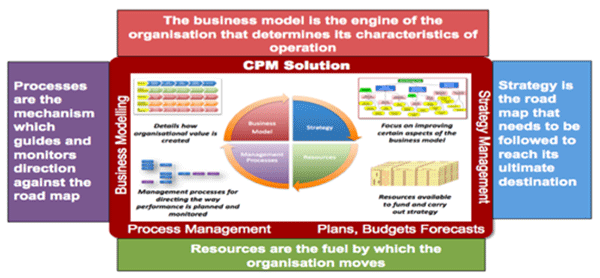
None of these components can be run in isolation - the degree of integration will determine how ‘smooth the ride’ will be.
Around this central CPM system will be a range of BI analytical applications that provide insight into particular aspects of each component. This insight is used to formulate plans to improve the operation of the business model.
The role of management reporting is to bring all relevant information together in context – i.e., to link strategy with the business model and resources in a transparent and usable format to motivate the many people involved to make the best-informed decisions. Those decisions will typically lead to altering the business model, modifying or developing new strategic initiatives, and, where necessary, re-allocating resources. All of which is performed under the control of management processes.
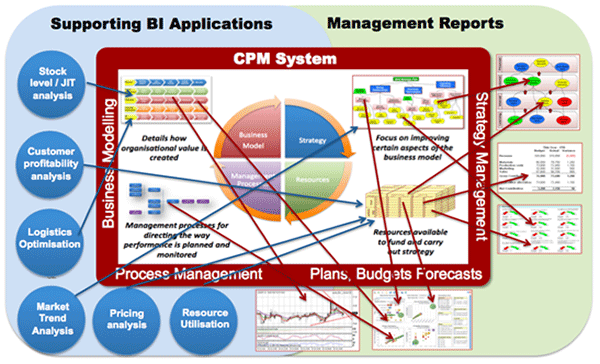
Implementing the Framework
Performance management is all about making decisions on the operation of the business model and any associated strategy improvement initiatives. What goals should be set? What things have to be done to achieve those goals? How much will it cost? How much did it cost? What will it cost in the future? Is the outcome worth it? What changes should be made? Why has a past change been agreed? And so on.
These decisions are typically made through a series of activities based on information presented to a user.
Therefore, when implementing the CPM framework, three things are necessary:
- The structure of the business model holds information on its performance and the impact of the strategy.
- The associated workflow through which it gets updated and monitored.
- The data entry screens and reports are given to users that directly support the decisions to be made. The next sections take each of these in turn.
Subscribe to
FP&A Trends Digest

We will regularly update you on the latest trends and developments in FP&A. Take the opportunity to have articles written by finance thought leaders delivered directly to your inbox; watch compelling webinars; connect with like-minded professionals; and become a part of our global community.


